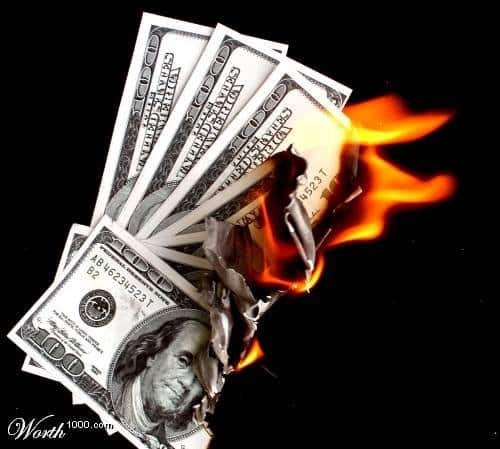Investors in Financials lose $10 billion
The Financial Times’ blog Alphaville is reporting today that those investors who ponied up for shares in financial institutions after the financials wrote down billions and needed additional capital – those investors – lost $10 billion! Basically, its like throwing good money after bad. Investments in many of these institutions is dead money until the writedowns stop.
Investors who backed the recent drive by U.S. financial companies to raise capital are sitting on nearly $10bn in paper losses amid a continued slump in the sector’s shares, an FT analysis shows. The negative returns suffered by investors are likely to make it more difficult and expensive for U.S. financial groups to tap equity markets if, as expected, they are forced to raise more capital. Investors who bought the $65bn-plus in common and convertible shares issued by large U.S. financial institutions since last October have seen their total investments fall by more than $9.7bn – a negative return of about 15% – according to an FT analysis of Dealogic data.
–FT Alphaville, 16 Jun 2008
 When individuals, sovereign wealth funds and institutional investors stop giving these institutions more capital, the bottom will fall out of the financial services sector, and we will reach capitulation. As a result, some institutions will fail. But, at that point, the surviving institutions will be very cheap. Then, the financials will be screaming bargains and that is the time to buy.
When individuals, sovereign wealth funds and institutional investors stop giving these institutions more capital, the bottom will fall out of the financial services sector, and we will reach capitulation. As a result, some institutions will fail. But, at that point, the surviving institutions will be very cheap. Then, the financials will be screaming bargains and that is the time to buy.
The reason we have not reached bottom is that investors refuse to believe that more writedowns are to come (see link here). I have said time and again that the level of writedowns due to mortgage credit losses will continue to be underestimated because so many do not understand the magnitude of the bubble which has created this problem. The losses will not be limited to subprime RMBSs (residential mortgage backed securities). They will encompass Alt-A and some prime loans as well. These losses and writedowns have yet to occur.
Moreover, there will be a negative feedback loop with the real economy from the balance sheet deleveraging. This will actually create more writedowns. The full measure of real economy-related credit losses have yet to be realized. Other areas where writedowns may occur include CRE (Commercial Real Estate), Construction Loans, Leveraged Loans, Credit Card and Auto ABSs (Asset-backed securities), High Yield corporate debt and sovereign debt.
The Lehman Brothers debacle began the second writedown phase. Most commentators assumed that the collapse of Bear Stearns and its rescue by JP Morgan Chase spelled the end of turmoil. However, financial institutions are carrying significant exposure to other asset classes on their books.
This is one reason regional financials in the US, especially in the Midwest among institutions like KeyWest, Fifth Third and National City have been hit. This is also why UK banks and house builders have suffered of late. Investors are waking up to the international nature of the crisis, understanding that writedowns in the UK, Spain and Ireland have yet to occur. Whether Canada and Australia’s bubbly markets join suit in due course remains to be seen.
So, my advice is to sit tight and wait for signs that the bottom has finally fallen out of these stocks and that investors have capitulated. Then, there will be a lot of companies worth buying.
Investors hit $10bn loss in U.S. financials
Investors who backed U.S. financial companies’ drive to raise much-needed capital are sitting on nearly $10bn in paper losses amid a continued slump in the sector’s shares, a Financial Times analysis shows.
The negative returns suffered by investors are likely to make it more difficult and expensive for U.S. financial groups to tap equity markets if, as expected, the credit crunch forces them to raise more capital.
“Raising funds from equity investors is becoming increasingly complicated because the performance of financial stocks during and after the spate of fund-raisings has been so abysmal,” said a Wall Street banker who advises institutions.
The setbacks suffered by equity investors come as sovereign wealth funds – a rich source of capital at the beginning of the crisis – have moved to the sidelines after seeing the value of investments fall in companies such as Citigroup, Merrill Lynch and Morgan Stanley.
Investors who bought the $65bn-plus in common and convertible shares issued by large U.S. financial institutions since last October have seen their total investments fall by more than $9.7bn – a negative return of about 15 per cent – according to an FT analysis of Dealogic data.
Those who took part in the $1.2bn recapitalisation of the bond insurer Ambac last March are nursing paper losses of more than 70 per cent. And fund managers who backed a $1.2bn capital raising by fellow monoline insurer MBIA have seen their investment shrink by 60 per cent.
Shareholders in Citigroup who thought that the sharp fall in the stock made last month’s $4bn share issuance a buying opportunity face a 24 per cent loss.
Of the 20-plus fund raisings by U.S. banks and insurers since the onset of the crisis, only two – by the student loan provider Sallie Mae and the regional lender Sovereign Bancorp – show a small positive return.
See: Credit Crisis Timeline for a full list of writedowns and capital raising by institution and a timeline of the credit crunch.
Comments are closed.